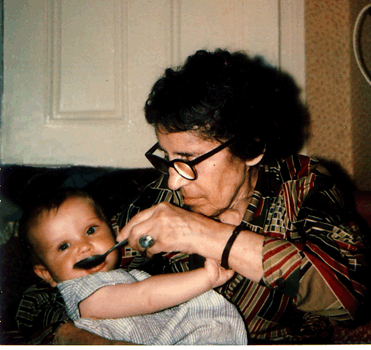The Harris Meltzer Trust Homepage
 |
| To contact the HMT click here |
 |
 |
 |
 |
 |
ims and history
Esther Bick
1901-1983
|
'Esther Bick was a gifted teacher and therapist ... those who worked closely with her knew the range of her grasp of the nature of mental processes and the depth of her knowledge of the human condition.'
Donald Meltzer
click here |

Nusia Bick with a grandson of Martha Harris, 1978
(photo: Adrian Williams)
|
'She had a vision of how lives might be improved by psychoanalysis, a burning desire to communicate this in her teaching, and little tolerance for attitudes which stood in the way of this.'
Martha Harris
click here
|
Esther Bick (known to her friends as Nusia) was born of Jewish parents in Poland and studied under Charlotte Bühler in Vienna. Here she began to develop a method for the observation of infants and young children which took into account the need for both scientific objectivity and for making use of the emotional experience of the observer. Most of her immediate family died in the holocaust; however she reached London in 1938, then worked in Manchester where she had some analysis with Michael Balint. She then moved back to London, had analysis with Melanie Klein, and qualified as a psychoanalyst, whilst working in child guidance clinics.
John Bowlby of the Tavistock Clinic asked Bick to provide a training course for analysts, and she developed a course founded on infant observation, with a view to enhancing the capacity to perceive the primitive and fundamental psychic realities of the concrete inner world described by Klein. She regarded this capacity as essential for the analysis of adults as well as of children, and as a result of her conviction, some experience of infant observation became part of most of the British trainings. When she left the Tavistock this course was taken over and fully developed by Martha Harris, who together with Donald Meltzer promoted Bick's infant observation techniques in relation to analytic training and therapy in other countries: in particular Argentina, Italy and France. Esther Bick herself had taught regularly in Italy, France and Uruguay. Meltzer and Harris described her as having 'a touch of genius'.
Esther Bick wrote little, awkwardly and reluctantly, but the spirit and tenets of her work have been passed on. As a result her few papers have proved highly influential. For an account of her legacy at the Tavistock by Margaret Rustin click here. Accounts of supervision with Bick are included in: Ann Cebon click here, Alessandra Piontelli click here, Looking and Listening (edited by Marisa Melega et al), click here. Additional glimpses of Bick at work may be seen in Gammill, click here. For a biography click here.
|
Publications
Child analysis today International Journal of Psychoanalysis, 43: 328-32, 1962.
The experience of the skin in early object relations International Journal of Psychoanalysis, 49: 484-86, 1968.
Notes on infant observation in psychoanalytic training International Journal of Psychoanalysis, 45: 558-66, 1964.
(The above papers are reprinted in The Tavistock Model: papers on child development and analytic training by Martha Harris and Esther Bick, click here.)
Further considerations on the function of the skin in early object relations British Journal of Psychotherapy, 2 (4), 1986 (together with a discussion by Donald Meltzer, click here)
|
|
| website by www.bournestudios.co.uk |

